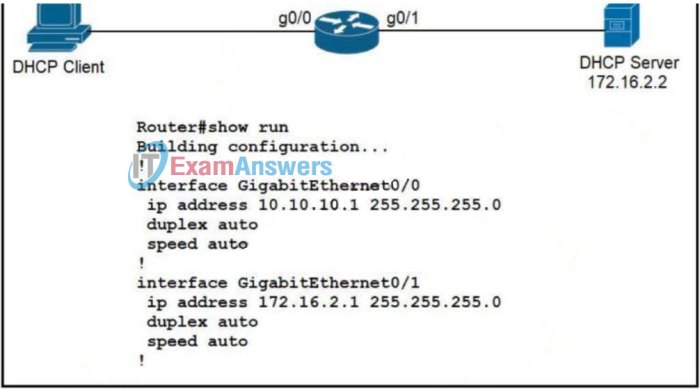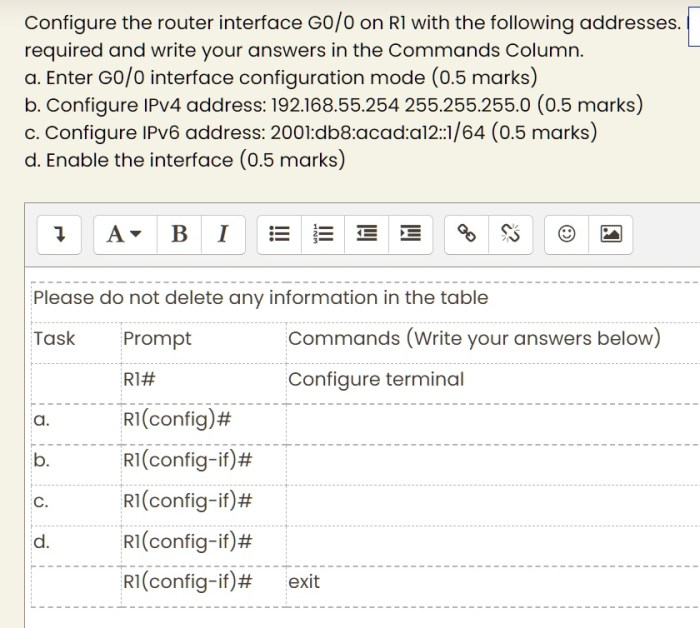Refer to the exhibit a network administrator is configuring – Refer to Exhibit A: Network Administrator Configuration Guide, a comprehensive resource for network configuration, provides invaluable insights into the process of optimizing network performance. This guide equips network administrators with the knowledge and techniques necessary to configure network devices effectively, ensuring seamless network operation and enhanced connectivity.
Delving into the intricacies of network configuration, this guide explores the purpose and benefits of configuring a network, outlining the various types of network configurations and providing real-world examples. It further delves into the steps involved in configuring network devices, explaining the configuration options available and demonstrating how to configure specific network devices.
Network Configuration Overview

Network configuration involves customizing network devices to optimize network performance and security. It allows network administrators to define network parameters, such as IP addresses, routing protocols, and security settings, to ensure seamless communication and data exchange.
Different types of network configurations include:
- Static configuration: Manually assigning network parameters to each device.
- Dynamic configuration: Automatically assigning network parameters using protocols like DHCP.
- Cloud-based configuration: Managing network devices remotely through cloud-based platforms.
Common network configurations include:
- VLANs (Virtual LANs): Logically dividing a physical network into multiple virtual networks.
- Routing: Establishing paths for data packets to travel between networks.
- Firewall configuration: Setting up rules to control incoming and outgoing network traffic.
Configuring Network Devices: Refer To The Exhibit A Network Administrator Is Configuring

Configuring network devices involves accessing their configuration interfaces (e.g., web-based or command-line) and modifying the appropriate settings. The steps include:
- Identify the network device’s IP address.
- Access the configuration interface using the IP address.
- Configure the necessary parameters, such as IP address, subnet mask, and default gateway.
- Save and apply the configuration changes.
Configuration options may include:
- Network interface settings: IP address, subnet mask, default gateway.
- Routing protocols: RIP, OSPF, BGP.
- Security settings: Firewalls, access control lists (ACLs).
Specific device configuration instructions vary depending on the device manufacturer and model.
Using Exhibit A
Exhibit A provides a comprehensive overview of the network configuration process, including:
- Step-by-step instructions for configuring various network devices.
- Examples of common network configuration tasks.
- Troubleshooting tips for resolving network configuration issues.
To use Exhibit A, refer to the specific section relevant to the network configuration task being performed. Follow the instructions carefully, paying attention to the specific device model and network requirements.
Troubleshooting Network Configuration Issues
Common network configuration issues include:
- Incorrect IP address or subnet mask.
- Missing or incorrect default gateway.
- Routing protocol misconfiguration.
- Firewall blocking necessary traffic.
To troubleshoot network configuration issues:
- Verify network cable connections.
- Check IP address and subnet mask settings.
- Test connectivity using ping or traceroute commands.
- Refer to Exhibit A for troubleshooting tips specific to the network configuration task.
Best Practices for Network Configuration

Best practices for network configuration include:
- Documenting network configurations for future reference and troubleshooting.
- Backing up network configurations regularly to prevent data loss.
- Using strong passwords and access control lists (ACLs) to protect network devices.
- Regularly updating network firmware and software to address security vulnerabilities.
FAQ Insights
What is the purpose of Exhibit A?
Exhibit A provides detailed information and instructions for configuring network devices, serving as a valuable resource for network administrators.
How can I use Exhibit A to troubleshoot network configuration issues?
Exhibit A includes troubleshooting tips and techniques that can assist network administrators in identifying and resolving network configuration issues.
What are some best practices for network configuration?
Refer to Exhibit A for guidance on best practices for network configuration, including documentation, backups, and security measures.